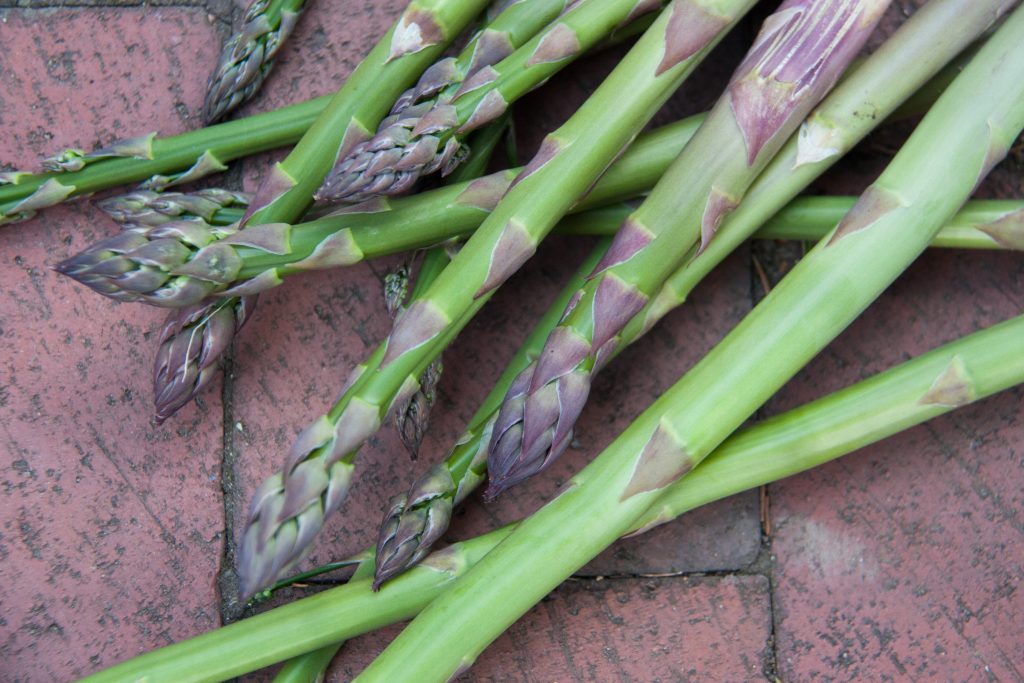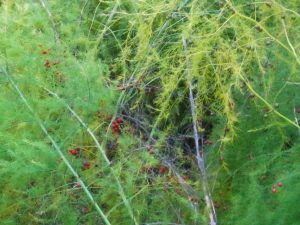
There are multiple species of wild asparagus that grow worldwide, but in the United States, you’ll forage for Asparagus officinalis, the exact same asparagus you pay big bucks for at the grocery store. Technically it’s a feral species. Animals eat and spread asparagus seed, helping the plant escape cultivation. Whether cultivated or feral, asparagus is one of my favorite vegetables.
How to Spot Wild Asparagus Plants
Asparagus can be tricky to forage for not because it’s rare, but because young, tender spears are hard to spot in spring, when they’re hidden by weeds and grasses. It’s much easier to locate almost every other time of year.
– In summer, look for tall, thin green spears with multiple branches radiating out at 90 degree angles from the main, vertical stem. A mature asparagus stalk has a triangular, almost Christmas tree shape, and the branches have a delicate, ferny look.
– In late summer, a ferny asparagus spear may be dotted with bright red berries.
– In fall, asparagus foliage is bright yellow and easy to spot from a distance.
– In winter, and very early spring, look for dried brown stems, three or four feet tall. They may be upright, or bent and fallen next to where new sprouts will emerge.
– If you see asparagus during its non-edible season, make a mental note. Or even better, drop a pin on a GPS map so you can come back to it easily in spring, when the asparagus is ripe and ready.
How to Cultivate Wild Asparagus (this is not as oxymoronic as you might think)
Asparagus is a perennial vegetable, i.e. the gift that keeps on giving. As a forager, there are things you can do to help your found asparagus patches be more productive:
1) Leave behind a spear or two to allow the plant to photosynthesize and store energy for next year’s crop.
2) Later in spring, leave the tallest stalk or two on each plant. These will be more fibrous and less wonderful to eat and leaving them behind will maintain the strength of the plant.
3) An asparagus plant that is properly harvested will continue to put up new sprouts over several weeks, so it’s worth revisiting your plants every few days. Spears may grow up to an inch per day, so a nubby little spear on Monday may be worth harvesting on Friday.
4) Asparagus can be harvested as long as the heads are tightly closed. If you come across a plant with stalks that are two feet tall with the heads still closed, snap off the top eight inches; they should still be tender and tasty.


Where to Look for Asparagus
Asparagus grows best in full sun. You’re most likely to find it in open fields and sunny roadsides, not under a canopy of trees. Asparagus also requires moisture, the kind you might find along fence lines, ditches, and hedgerows. It doesn’t want wet feet, so you won’t find it stream side. You also won’t find it growing in dry conditions.
As a forager, you’ll see asparagus spears in many different sizes, from 1/4 inch in diameter to more than an inch thick. I’m writing this in bold because so many people don’t know this: Thickness is not a mark of flavor! It may be the result of many things: the age of the plant, whether this is the first flush of growth or second, or where the spear is located in the crown of the plant. Thick asparagus spears can be every bit as tender and delicious as the half inch thick spears you’re used to finding in the produce aisle.
What to do with your Asparagus
When I’m foraging for asparagus, I often eat it raw. It’s delicious that way, just minutes after being cut. (Store-bought doesn’t have quite the same charm raw.) I’m also a fan of simple steamed asparagus, served with an herby vinaigrette. And if you’ve been a very lucky forager and come home with both asparagus and a load of morels, try this recipe for asparagus and mushroom bread pudding.
Leave a Reply